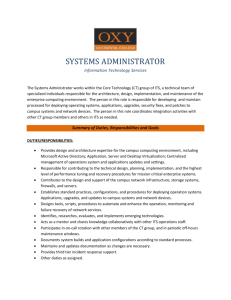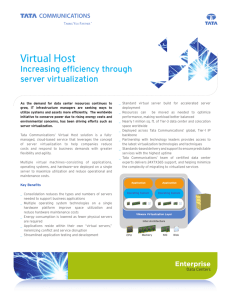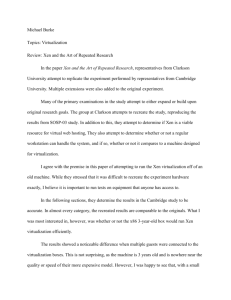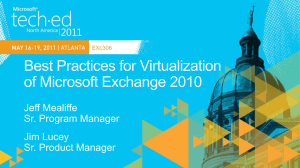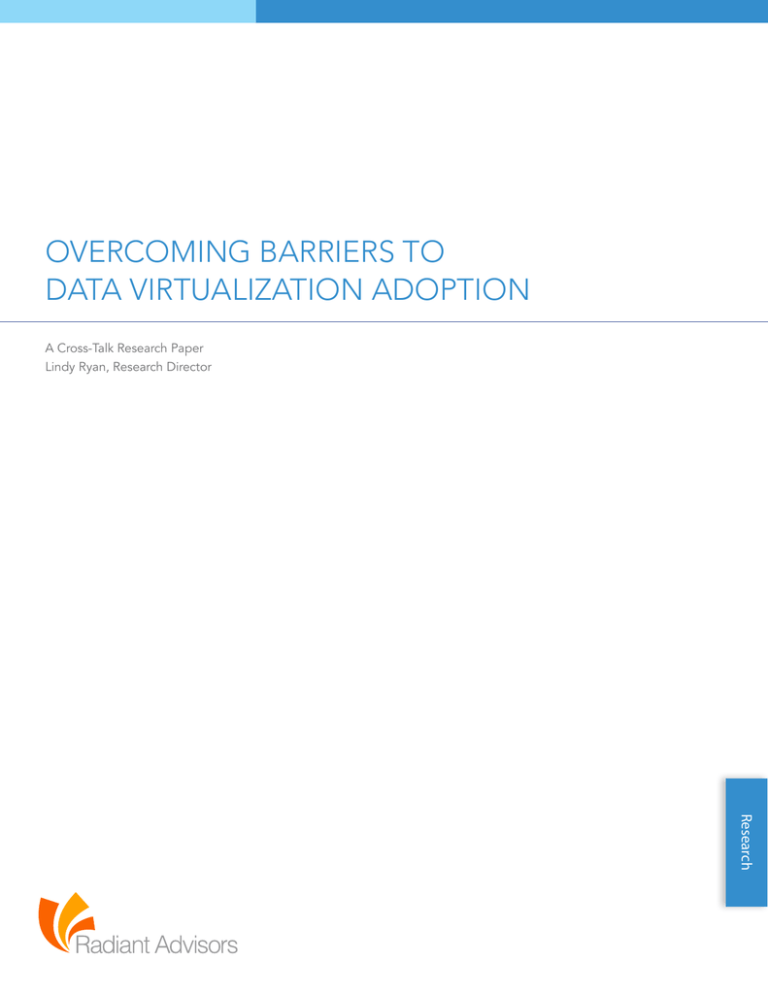
OVERCOMING BARRIERS TO
DATA VIRTUALIZATION ADOPTION
A Cross-Talk Research Paper
Lindy Ryan, Research Director
Research
Research
This document contains Confidential, Proprietary and Trade Secret Information (“Confidential
Information”) of Radiant Advisors. No part of this publication may be reproduced, stored in a retrieval
system, or transmitted in any form or any means electronic or mechanical, including photocopying
and recording for any purpose other than the purchaser’s personal use without the written
permission of Radiant Advisors.
While every attempt has been made to ensure that the information in this document is accurate
and complete, some typographical errors or technical inaccuracies may exist. Radiant Advisors does
not accept responsibility for any kind of loss resulting from the use of information contained in this
document. The information contained in this document is subject to change without notice.
All brands and their products are trademarks or registered trademarks of their respective holders and
should be noted as such.
This edition published September 2014.
Overcoming Barriers to Data Virtualization Adoption
Research
Table of Contents
Introduction
1
Cross-Talk Research Methodology
2
Barrier #1: Choosing Data Virtualization
3
Barrier #2: identifying the Lynchpin Use Case 6
Barrier #3: Assigning Roles and Responsibilities
9
Barrier #4: Selecting a Vendor
11
Conclusion
14
Overcoming Barriers to Data Virtualization Adoption
Research
Introduction
The challenges of data management are getting exponentially harder. With
the ever-increasing quantities, sources, and structures of data – as well as the
insurgence of new tools and techniques for storing, analyzing, and deriving deeper
insights from this information – data-driven companies continue to evaluate and
explore data management technologies that better integrate, consolidate, and
unify data in a way that offers tangible business value.
Data virtualization is so compelling because it addresses business demands for
data unification and supports high iteration and fast response times, all while
enabling self-service user access and data navigability. However, adopting data
virtualization is not without its set of barriers. Primarily, these relate to building a
business case that can articulate the value of data virtualization in terms of speed
of integration alongside the ability to manage ever-growing amounts of data in a
timely, cost-efficient way.
Supported by Cisco Data Virtualization, Radiant Advisors had the opportunity
to further explore and understand the barriers experienced by companies
considering data virtualization adoption, and then to pose these questions to
companies that have already adopted data virtualization to glean their insights,
best practices, and lessons learned. Together, the two halves of this research
facilitate a practicable, independent, and unscripted “cross-talk” to fill information
gaps and assist companies in overcoming barriers to data virtualization adoption.
Overcoming Barriers to Data Virtualization Adoption
1
Research
Cross-Talk Research Methodology
The first portion of the research independently solicited the participation of
many companies within the Radiant Advisory Network to properly harness a
wide perspective across many industries and organizations to identify common
concerns and questions regarding barriers to data virtualization from a broad, preadopter community. The companies included were very interested in adopting
data virtualization and either currently not using data virtualization or evaluating
the technology for potential adoption. Gathering this perspective ranged from
structured discussions at industry events to formal interviews with BI team leads.
As a result, we identified areas of concern and isolated critical questions in need of
response from the post-adoption community.
These top-of-mind concerns were then posited to companies that have already
adopted and implemented data virtualization within their organization. To facilitate
this exchange of information, current data virtualization-successful customers
were solicited from Cisco’s existing customer network. Representatives from
each company were invited to independently and anonymously share insights,
best practices, and lessons learned in overcoming barriers to data virtualization
adoption.
Following the completion of all interviews, detailed research notes from both
consorts of companies were synthesized with Radiant Advisors’ expertise and
thought-leadership to distill key insights that filled the information gaps identified
by pre-adopter companies.
Ultimately, this research and the following report are intended to guide potential
adopters to overcome perceived barriers to data virtualization adoption by
facilitating an independent, unscripted “cross-talk” between potential adopters
and those who have already moved forward.
Overcoming Barriers to Data Virtualization Adoption
2
Research
Barrier #1: Choosing Data Virtualization
With so many available technologies and approaches to data management, the first
question that potential adopters consider is the rationale for the decision to adopt
data virtualization opposed to other approaches (i.e. data federation, master data
management (or, MDM), the data lake, extract-transform-load (or, ETL), etc.). Some
companies have expressed that MDM provides a more manageable and intuitive
approach, rather than consolidating multiple copies of data. Others wonder
if data virtualization will eventually take a back burner in data management as
the concept of the data lake grows in popularity and acceptance. Finally, there
is lingering ambiguity about how much data virtualization is needed for batch
analytics, real-time insight, and interactive queries – and if data virtualization can
“When you move really fast,
become oversaturated with too much data from the same source.
customers are really happy
Then, after deciding on data virtualization has been nominated as the preferred
– every bit of slowness
directly impacts customer
approach, the next “biggest hurdle” has been expressed as how to effectively
communicate what data virtualization is – both as a data management construct
and as a value proposition – to C-level executives who are critical for buy-in and
championship at the business level. It has been noted by IT teams that business
happiness.”
executives tend to “get lost in the sauce” and dwell on trying to navigate the
differences between different data integration technologies, and that distinctions
- A commercial, web-based
aren’t meaningful at the C-level. Frankly, this makes the ability to gain executive
services company
buy-in and support difficult. Companies evaluating data virtualization would like to
better understand how to take data virtualization “from a concept to a framework”
in a way that is communicable and meaningful to executive stakeholders.
Overcoming the Barrier
Current data virtualization users note that sometimes you can’t be traditional –
you have to do something different. That said, the value proposition is simple: data
virtualization avoids longer data integration development lifecycles that are riskier
to meet fast paced business needs, is faster to market and deploy, and supports
the changes that happen on-the-fly in the organization.
Companies that use data virtualization have described it as a seamless and quick
way to “insulate and adapt,” by using an abstraction layer to “snap together” data,
Overcoming Barriers to Data Virtualization Adoption
3
Research
Barrier #1: Choosing Data Virtualization
change views, present the same data from multiple places, and change the logic
behind it. The reality is that (business) users want unfettered access to unaltered
data, and they want it fast. Using data virtualization avoids depleting alreadyscarce IT time to build a model that ends up not meeting expectations – inevitably
frustrating business – and instead offers a quick scanning tool to build in a way
that responds immediately to business changes and needs.
Data virtualization has, too, been seen as a way to expand IT’s potential – described
as a “capacity increasing initiative,” if you will. As a layer of abstraction, data
virtualization lives between data sources to establish unified semantic context
and data access without actually impacting the data source structure. It provides a
mechanism to bring IT closer to the business, too, moving away from a very techheavy and IT-driven function to one that can be translated into business language
and moved closer to the business user for richer enterprise-wide collaboration.
Finally, data virtualization has been implemented as a vehicle to polyglot
persistence (persisting data in the data store best suited for its purposes). With
the influx of new databases, the ability to store data in more performant ways
than traditional databases becomes increasingly more imperative. A move to an
abstraction layer has proven both empowering and agile to understand what data
exists where and what the access patterns are around that data, as well as enables
the ingestion of more on-premise and cloud data. Ultimately, from an executive
management perspective, the value of data virtualization aligns with the ability to
provide enterprise data back out for analytics and visualization, and moves away
from the use of “black box” enterprise systems that can make it difficult to acquire
data in real-time.
One interesting note is that the reasons for choosing data virtualization as a
core technology and the reasons for keeping it are not always one in the same.
For example, one Colorado-based non-profit explained that they choose data
virtualization to provide a layer of abstraction between data stores and users of
those stores with the idea that IT would be easily able to switch out the back end
with no changes required to the front end. However, while the use case remains
valid, at this particular organization it turned out to be an internal fallacy as the
Overcoming Barriers to Data Virtualization Adoption
4
Research
Barrier #1: Choosing Data Virtualization
company’s user groups all had power users who demanded access to unaltered
source system data and resisted the approach. In the end, this company chose to
keep data virtualization while other investments were canned (including MDM,
ETL, and rapid DW development) because of its success in using data virtualization
to enable both logical data warehousing and real-time data provisioning for
services.
Overcoming Barriers to Data Virtualization Adoption
5
Research
Barrier #2: Identifying the Lynchpin Use Case
Potential data virtualization adopters are eager to understand (and learn from)
the experiences of post-adopters regarding how to “get started” using a data
virtualization layer – including what elements informed that decision, the resulting
lessons learned, and how that initial experience has been applied to an overall
data virtualization growth strategy.
“You can’t rebuild data every
day, so you need the ability
With so many possible “lynchpin” use cases, many potential data virtualization
adopters have expressed concern that data virtualization can seem “too
to get what you want on the
conceptual” of a concept to hone in one a single opportunity that simultaneously
fly. In a [traditional] data
justification opportunity. Specific questions from potential adopters asked for
warehouse you build all or
takes advantage of agility, is speedy to start, and illustrates a real business value
further exploration into whether there have even been use cases that have been
proven to be impossible to do without data virtualization – as opposed to more
you build nothing because
difficult – and if there were any specific implementation challenges (or “gotchas”)
the data is persisted there –
were addressed.
but with data virtualization
that were uncovered during a data virtualization implementation, and how these
Moving forward, once the initial hurdle of launching data virtualization has been
you can build and rebuild on
overcome, potential adopter thoughts turn to how data virtualization is expanded
the fly with data as needed.”
phased adoption and implementation. This path of thought also includes which
within the enterprise as part of a larger growth strategy and seek insights to guide
implementation strategies to avoid with data virtualization, to ensure that it is
- A cable telecommunications
deployed efficiently, effectively, and properly throughout the organization.
company
Overcoming the Barrier
Post-adoption companies validate the importance of the proper lynchpin use case
to prove the value of data virtualization to the organization and earn executive
buy-in. The following represent a sampling of data virtualization lynchpin use
cases that successfully introduced data virtualization to the organization:
• One media company had invested nearly $500k in the development of a physical
customer data mart that was, in the end, unable to be built according to established
Overcoming Barriers to Data Virtualization Adoption
6
Research
Barrier #2: Identifying the Lynchpin Use Case
timeline parameters and money allocated. Because the business had already
invested significant resources in the project, IT was unable to ask for additional
funding and, instead, had to deliver on the requirements document without
additional cost or time. With data virtualization, they were able to build virtually
and deploy within three months with only supplemental professional services
assistance. For this company, their lynchpin case was initiated as an opportunity
for creative problem solving.
• A commercial, web-based services company approached data virtualization
adoption as a way to overcoming a broken data environment. Previously at this
company, some databases weren’t well designed and were “bulled together” with
brute force, without consideration for architecture and business rules. Because of
this, additional BI tools couldn’t be added on top of the existing infrastructure and
technologies already in place couldn’t be used as intended. The initial hurdle was
trying to run poorly performing queries with handwritten SQL code, and initiatives
in ETL helped to properly structure for analytics but still left other operational and
real-time data unable to be seamlessly interlinked. Then, when the company’s
contact management system began a redesign of ownership hierarchies that
rendered hundreds of reports obsolete, IT was left with no time to rebuild a
fragmented data warehouse. Instead, they turned to data virtualization to insulate
and adapt the business as the data environment changed from underneath too
fast to approach in traditional ways.
• Another multinational agrochemical and biotechnology corporation tucked
data virtualization adoption discreetly within a $1 million business transformation
project aimed at enabling a “new start” in its business information platform. As
the project rolled out, data virtualization was simultaneously deployed across the
organization. The reasoning was straightforward: within any organization there is
a relatively small set of data (say, 15% by this company’s estimate) that is used over
and over again. This company wanted to take this highly-reusable data and make it
self-serving, thereby partnering business and IT to collaborate directly to address
the business’ desire to see their own data in their own language, vet definitions,
and then translate that into myriad data virtualization-enabled reporting tools as
a single source of extraction and value.
Overcoming Barriers to Data Virtualization Adoption
7
Research
Barrier #2: Identifying the Lynchpin Use Case
• Lastly, a children’s non-profit organization used data virtualization to spur a
project that had been languishing for over a year to due the fact that modeling
it in a traditional EDW process (staging, ETL, business model data warehousing,
data view – “or worse yet, a cube” --, report) had proven far too cumbersome and
interdependent. After hearing other industry success stores on data virtualization,
this company was emboldened to dust off the old project, and set about to retiring
its traditional data warehouse. This was replaced with a logical data warehouses
that could meet organizational real-time data needs, however even this approach
was still unfamiliar territory fraught with struggle. Management stepped in and
helped foster organizational agreement on key terms and definitions. Ultimately,
the inclusion of a data virtualization layer allowed this company to provide both
operational and analytical reporting out of the same set of views, maximizing the
company’s operations and business value to its charitable endeavors.
Overcoming Barriers to Data Virtualization Adoption
8
Research
Barrier #3: Assigning Roles and Responsibilities
As potential adopters begin to roadmap data virtualization as an integral part of
data and organizational architectures, many see the identification and designation
of resources and roles within the BI team as an obstacle due to their inherently
competitive natures (i.e., who has the “rights” to work within the data virtualization
tool and is this person a data modeler or an ETL developer? Moreover, how do they
interact with the DBA?). There is the perception that creating a data virtualizationspecific team drives agility by consolidating work in a tight area with limited
“Even with those basic (and
resources, however there is a lack of clarity as to whether these roles should be
isolated to IT, or whether they should be isolated within the business, as an IT
significant) flaws, we saw
tremendous success and
acceptance [from using
brokerage team, or as part of a cross-functional team.
Separately from ownership, under the helm of roles and responsibilities, there is
additional concern regarding the handling of security and governance within a
data virtualization environment. With the need to drive access and visibility for
data virtualization] and
soon started to suffer from
discovery, many companies wonder how to enable a governed data discovery
environment that leverages data virtualization while still controlling individual
access and database security.
the semi-mythological
Overcoming the Barrier
‘perils of success.”
Adopted companies consistently noted that they retain small, interdisciplinary,
- A non-profit organization
and agile teams to fully deploy and manage data virtualization. Many companies
noted a team of between five to seven people that is centralized and consists of
both business and IT roles (two to three IT FTE with others part of the organizational
matrix). One investment-banking firm noted that responsibility shared among
multiple departments has enabled the capacity to virtually grow in a wellgoverned consistent fashion across the organization. Another non-profit noted
that these roles should, to some extent, be overlapping with each member having
some capacity to assist in other areas while maintaining specializations that align
to the core functions of the team.
Overcoming Barriers to Data Virtualization Adoption
9
Research
Barrier #3: Assigning Roles and Responsibilities
Specific core roles and responsibility
main responsibility is to ensure the server remains
available and accessible with no downtime to correctly
Application Administer
meet incoming demands, honor business service-level
agreements, and anticipate future demands
Governance Architect
Business Information
Owner
Developer
takes ownership of decide what should or should not
be built as virtual objects – and then, how to build
it – within the abstracted environment to sustain
a sharable, consistent model that provides proper
business semantics across the organization
work in tandems with the governance architect to
avoid a purely technical approach and retain the
business value of data virtualization
acts as the single point of authority to vet and
implement proposed changes within the data
virtualization environment as well as builds, optimizes,
and tunes the virtual objects
Most data virtualization teams also have a non-technical data virtualization
Champion that actively communicates with executive management to champion
data virtualization’s value and inclusion as a core technology within other areas
of the business. As a measuring point for data virtualization adoption within the
organization, some companies have also launched an Integration Competency
Center, too, to leverage the small data virtualization team for development
and training across the larger organization. Communication, community, and
awareness are essential, especially in areas of governing the abstraction layer
itself, which remains a moving target as both the role of data virtualization and the
business process of discovery continue to mature in the organization.
Overcoming Barriers to Data Virtualization Adoption
10
Research
Barrier #4: Selecting a Vendor
Finally, potential data virtualization adopters seek to cut through the marketing of
vendors and understand key differentiators between data virtualization vendors
in the space today. Additionally, potential adopters hope to navigate beyond
the vendor marketplace and benefit from lessons learned and best practices of
adopters that have already had the opportunity to evaluate competing vendors
and have had the opportunity to learn from hands-on, already in-use experience
with chosen tools. Further, they would like to insight on how the evaluation and
selection of a data virtualization vendor applies relative to the total tool and vendor
“We went with the
landscape and technology architecture, how it has performed since its adoption,
and how this affects the ongoing roadmap of the organization.
[data virtualization]
As a vendor differentiator, beyond product capabilities has been a distinct interest
approach because the
environment was changing
out from underneath way
in how vendors support ongoing training and learning events for users, including
the performance and responsiveness of vendor technical support. Additionally,
because potential adopters recognize that there will be a learning curve inherent
in adopting a new technology, they are interested in the level of training and
support services available, what has proven to be the most useful and invaluable
too fast to approach in
traditional ways.”
- A commercial, web-based
services company
for companies – and its technical and non-technical users – that are new to data
virtualization.
Overcoming the Barrier
Key differentiators when evaluating data virtualization vendors, according to
those companies who have already undertaken this journey and made a buying
decision, can be distilled into three areas: vendor/product maturity, industry
impact, and roadmap; product technical capabilities; and level of vendor support
and services.
Vendor/Product Maturity and Impact Across Industries
Time and time again, adopting customers remarked the importance of seeing a
vendor client-base that resonates with their respective industries as a measuring
stick by which to weigh the vendor’s strength and permeation amongst its
competitors. Another indicator of vendor/product maturity is its time in the market
Overcoming Barriers to Data Virtualization Adoption
11
Research
Barrier #4: Selecting a Vendor
and longevity with proven customer use cases. Further, adopting customers
looked for synergies in use cases that showcase product maturity and illustrate
how vendors have handled challenges trending in the market.
Ongoing transparency in where the vendor has been and where they are going
proves just as important to adopting customers, noting that the vendor roadmap
is critically important to the ongoing success of data virtualization. Adopting
customers also desired a vendor that allows users a voice into the product
development roadmap, and one that actively looks to incorporate emerging
technologies (such as the Cloud) to expand and refine existing capabilities.
Product Technical Capabilities
Of course, how the technology works and what it is capable of is a huge
differentiator during data virtualization vendor comparisons. In addition to the
distilled list of key differentiators below, price and total cost of ownership is, of
course, always an important factor in the buying decision.
•
Ease of use (User interface; allows development using SQL)
•
Availability of source system connectors (Databases, Web APIs, RESTful APIs)
•
Ease of ingesting new types of data sources
•
Ease of accessing data output (ODBC, JDBC)
•
Support for complex caching needs
•
Availability of clustering for redundancy
•
Ease of deploying changes to production environment
•
Visibility into execution plans
•
Scalability (a big concern in large enterprises -- DV strategic architecture)
•
Extensibility (ease of calling into and out of the DVL)
•
Impact analysis, or ease of identifying lineage both backward and forward
for any entity or attribute at any level (i.e. sources, source abstraction layer,
middle/conforming layers, demand layer, and publications)
•
Performance monitoring
•
Object level security
•
Optimization engine -- ability to create high performance execution plans
•
Pass-down optimizations
•
Audit logs for reviewing user access for governance and compliance
Overcoming Barriers to Data Virtualization Adoption
12
Research
Barrier #4: Selecting a Vendor
Level of Vendor Support and Services
Lastly, adopting customers chose a vendor that not only has proven successful
and has the right capabilities and roadmap to help customers continue to be
successful, but for one that takes the initiative to help their customers actively
succeed. This is measured in terms of both responsive technical support in helping
to investigate and resolve issues, as well as the level of vendor training provided
to the customers that minimize the learning curve and helped to leverage existing
internal knowledge.
Finally, customers noted that professional services offered by the vendor would
be helpful as they work to develop the right data virtualization environment,
particularly at the onset of implementation. This is primarily because customers
noted that they still struggle with what goes into a classic layer and what goes into
a data virtualization layer, and how these complement each other. One customer
called this balance between access and ownership a “political turf war” and said
that governed data virtualization requires a large cultural change, as it is difficult
to get true ownership, especially pertaining to semantic definitions.
Overcoming Barriers to Data Virtualization Adoption
13
Research
Conclusion
Data virtualization is a mature technology that has evolved with the data
management industry. However, while nearly every major research and consulting
firm delivers architectural blueprints that include a logical business semantic layer,
only some companies have implemented that component -- and even fewer
have enterprise-wide – leaving data virtualization the often-missed piece of an
overall unification strategy that includes incumbent, traditional ETL and data
replication. As a technology, data virtualization in itself isn’t a silver bullet, but
when implemented with governance and a rich methodology, it solves the bigger
problem of managing data volatility and addresses many pain points of business
and IT.
The reality today is that, without a robust consolidation strategy, business and
IT simply cannot keep up with the volatile landscape of surging data. More and
more, integration is becoming a lackluster blanket integration strategy: even if you
manage to do it, it invariably won’t last. Instead, a data unification strategy that
adopts data abstraction through data virtualization as a key integration strategy
solves data volatility and offers very immediate benefits to alleviate the pain points
of the organization, and maximizes the value of integrations whether physical or
abstracted.
To achieve the benefits of data virtualization, companies need to take the leap.
So, while barriers exist, they can be easily overcome -- many have done so already
and are achieving these benefits today. This research is a guidebook, providing a
living conversation from both sides of the adoption table, and intended to assist
potential adopters in overcoming barriers by leveraging the insights and lessons
learned of those who have already moved forward.
After overcoming barriers to data virtualization adoption, the next step is to plan
this technology as part of a long-term data integration strategy. Therefore, the
same discipline and diligence that is put into physical data integration should be
applied into the abstracted environment. Seek to quantify the reduction in both
development time and time to deployment leveraging data virtualization, and,
once these are quantified, double the benefit quotient by moving beyond the
immediate, localized benefit and looking farther to drive larger, enterprise-wide
strategic benefits.
Overcoming Barriers to Data Virtualization Adoption
16
About the Author
Lindy Ryan, Research Director, Data Discovery and Visualization, Radiant Advisors
As Research Director for Radiant Advisors’ Data Discovery and Visualization practice, Lindy
leads research and analyst activities in the confluence of data discovery, visualization, and data
science from a business needs perspective.
Sponsored by:
Cisco (NASDAQ: CSCO) is the worldwide leader in IT that helps companies seize the opportunities
of tomorrow by proving that amazing things can happen when you connect the previously
unconnected. Cisco Information Server is agile data virtualization software that makes it easy
for companies to access business data across the network as if it were in a single place.
To learn more about Cisco Data Virtualization
visit www.cisco.com/go/datavirtualization
About Radiant Advisors
Radiant Advisors is a leading strategic research and advisory firm that delivers innovative,
cutting-edge research and thought-leadership to transform today’s organizations into
tomorrow’s data-driven industry leaders.
Boulder, CO USA
Email: info@radiantadvisors.com
To learn more, visit www.radiantadvisors.com
© 2014 Radiant Advisors. All Rights Reserved.

